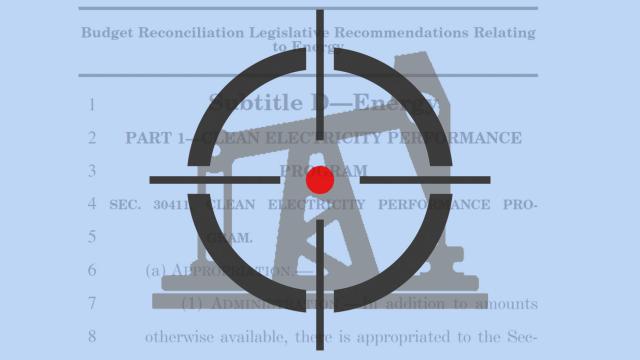
Climate measures like the Clean Electricity Performance Program could pose long-term challenges to oil and gas use. (Source: Hart Energy; Serhiy Smirnov, sirius1/Shutterstock.com)
In practical terms, the two massive spending bills plodding through Washington’s legislative process will not inflict any immediate harm on the outlook for fossil fuels when and if they pass, experts told reporters during a Sept. 22 briefing hosted by Duke University.
However, the $1 trillion bipartisan infrastructure bill that passed the Senate and awaits passage by the House, and the $3.5 trillion bill making its way through the budget reconciliation process are central to President Joe Biden’s climate initiative that aims to decarbonize the U.S. electric grid by 2035.
A key component of the budget reconciliation bill is the $150 billion Clean Electricity Performance Program (CEPP), which passed the House Energy and Commerce Committee on Sept. 14. The program uses a carrot-and-stick approach to compel utilities to increase the amount of clean electricity provided to customers by 4% year over year. Those that comply would be awarded grants by the U.S. Department of Energy. Those that fall short will owe money.
CEPP is not a done deal, however. Sen. John Cornyn (R-Texas) told Reuters Sept. 21 that he and fellow Republicans would ask the Senate parliamentarian to rule that the program does not qualify for budget reconciliation because it advances policy changes and its budget impacts are incidental.
If it does make it into law, CEPP places utilities reliant on natural gas in a bind. The only way gas meets the CEPP standard for clean energy is if the power plant uses carbon capture technology. But the costs associated with capturing carbon and storing it geologically are currently very high, and the costs of renewable sources like wind and solar have fallen.
There are efforts to accelerate carbon capture. The Department of Energy funds research to accelerate the development of carbon capture technologies.
“We’re not saying you can’t use natural gas under these policies, but it would be difficult for it to continue,” said Timothy Johnson, a Duke University faculty expert on energy systems planning, environmental quality and energy consumption. “Natural gas is—right now, given the power system we have—needed to compensate for variable renewable energy resources like wind and solar.”
But if that need is critical at the moment, Johnson expects it to diminish over time as the technology to store electricity produced by wind and solar develops.
Sticking around
The reality of climate legislation is that it is geared toward dramatic reductions in emissions of CO2 and other greenhouse gases into the atmosphere. Fossil fuels, especially coal, are major producers of those emissions, particularly in the areas of power generation and transportation.
“How do you reduce those emissions?” Johnson asked. “Well, energy efficiency is at the top of the list. Next, you try to electrify everything you possibly can. You need to make that electricity as clean as possible, which really means renewables and all the things you need to do to integrate renewables on the grid—storage, transmission, things like that.”
But the transition will take time, even if it moves at the improbable pace envisioned by the Biden administration’s legislation. That means that new vehicles equipped with internal combustion engines can still be sold until 2035, which means that most of those cars will still need gasoline near the end of their average lifespan in 2050.
“If you look at the decarbonization scenarios, there’s always a vestige of fossil fuel use for various reasons,” said Eric Rohlfing, executive in residence at Duke’s Energy Initiative and Nicholas Institute for Environmental Policy Solutions. In his previous role as senior technical adviser for the Advanced Research Projects Agency-Energy (ARPA-E) at the U.S. Department of Energy, Rohlfing worked on energy technologies that were not yet ready for private-sector investment.
The challenge, however, is that the scenarios that take fossil fuel use out to 2050 incorporate negative emission technologies to achieve a net-zero carbon environment. Those technologies so far only occupy space on a wish list, he said.
“They’re still in the research stage,” Rohlfing said. “We don’t know how to drive those costs down for those technologies and how to ramp them up to scale. These are significant research questions that have to be addressed and have to be addressed quickly.”
Recommended Reading
Iraq to Seek Bids for Oil, Gas Contracts April 27
2024-04-18 - Iraq will auction 30 new oil and gas projects in two licensing rounds distributed across the country.
Tethys Oil Releases March Production Results
2024-04-17 - Tethys Oil said the official selling price of its Oman Export Blend oil was $78.75/bbl.
Exxon Mobil Guyana Awards Two Contracts for its Whiptail Project
2024-04-16 - Exxon Mobil Guyana awarded Strohm and TechnipFMC with contracts for its Whiptail Project located offshore in Guyana’s Stabroek Block.
Deepwater Roundup 2024: Offshore Europe, Middle East
2024-04-16 - Part three of Hart Energy’s 2024 Deepwater Roundup takes a look at Europe and the Middle East. Aphrodite, Cyprus’ first offshore project looks to come online in 2027 and Phase 2 of TPAO-operated Sakarya Field looks to come onstream the following year.




